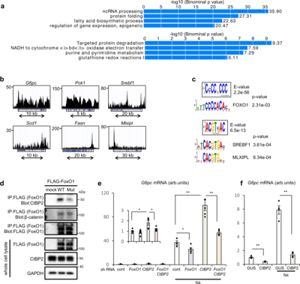PRESS RELEASE
- Research
- 2021
The transcriptional corepressor CtBP2 serves as a metabolite sensor orchestrating hepatic glucose and lipid homeostasis
Authors
Motohiro Sekiya, Kenta Kainoh, Takehito Sugasawa, Ryunosuke Yoshino, Takatsugu Hirokawa, Hiroaki Tokiwa, Shogo Nakano, Satoru Nagatoishi, Kohei Tsumoto, Yoshinori Takeuchi, Takafumi Miyamoto, Takashi Matsuzaka, Hitoshi Shimano
Abstract
Biological systems to sense and respond to metabolic perturbations are critical for the maintenance of cellular homeostasis. Here we describe a hepatic system in this context orchestrated by the transcriptional corepressor C-terminal binding protein 2 (CtBP2) that harbors metabolite-sensing capabilities. The repressor activity of CtBP2 is reciprocally regulated by NADH and acyl-CoAs. CtBP2 represses Forkhead box O1 (FoxO1)-mediated hepatic gluconeogenesis directly as well as Sterol Regulatory Element-Binding Protein 1 (SREBP1)-mediated lipogenesis indirectly. The activity of CtBP2 is markedly defective in obese liver reflecting the metabolic perturbations. Thus, liver-specific CtBP2 deletion promotes hepatic gluconeogenesis and accelerates the progression of steatohepatitis. Conversely, activation of CtBP2 ameliorates diabetes and hepatic steatosis in obesity. The structure-function relationships revealed in this study identify a critical structural domain called Rossmann fold, a metabolite-sensing pocket, that is susceptible to metabolic liabilities and potentially targetable for developing therapeutic approaches.
Nature Communications : https://www.nature.com/articles/s41467-021-26638-5

